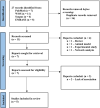A Systematic Evidence-Based Review Regarding miRNA Polymorphisms in Recurrent Implantation Failure
- PMID: 40740435
- PMCID: PMC12309981
- DOI: 10.1002/rmb2.12670
A Systematic Evidence-Based Review Regarding miRNA Polymorphisms in Recurrent Implantation Failure
Abstract
Background: This systematic review aimed to evaluate whether specific single nucleotide polymorphisms (SNPs) in miRNAs are associated with recurrent implantation failure (RIF).
Methods: A comprehensive literature search was conducted across PubMed-MEDLINE, Web of Science, Scopus, and the Excerpta Medica DataBASE.
Results: The Newcastle-Ottawa Scale (NOS) yielded an intermediate to high quality, with one study rated with 6 stars, and the remaining four with 7 stars. RIF risk-related genotypes included miR-196a, miR-449b, miR-34a, miR-146aCG+GG-miR-196a2CC, miR-149TT-miR-196a2CC, miR-196a2CC-miR-499AA, miR-608GC-miR-938CC, miR-27aAG-miR-423CC/miR-604AG/GG and miR-34aC>A AA-miR-130aG>A GG. Protective combinations included miR-1302-3, miR-631II-miR-1302-3CT, and miR-938CC-miR-1302-3CT. Protective allele combinations G-T-T-A, C-T, T-T-G, T-T and G-C-A-G, G-A-G, A-G-G were less frequent in RIF cases, whereas A-T-C, T-C-C-T, T-C-T, A-C-G-A, A-A-G-G, G-A-A-A, A-A-C-A and G-G-A haplotypes were more commonly associated with increased risk. Notably, miR-608 GC+CC, miR-1302-3 CC, miR-27a AG+GG, miR-423 CA+AA, miR-604 AG+GG, miR-222 GT+TT, and miR-34a GA+AA were associated with altered coagulation parameters. Additionally, miR-222 correlated with decreased creatinine levels, the G>T mutation with elevated follicle-stimulating hormone (FSH), miR-34aC>A AA genotype with reduced thyroid-stimulating hormone (TSH) levels, and CA+AA with increased blood urea nitrogen (BUN) levels.
Conclusions: This systematic review highlights that specific miRNA SNPs and haplotype combinations are significantly associated with either increased susceptibility to or protection against RIF.
Keywords: allele; coagulation; genotype; hormonal; in vitro fertilization; microRNA; recurrent implantation failure; renal; single nucleotide polymorphism.
© 2025 The Author(s). Reproductive Medicine and Biology published by John Wiley & Sons Australia, Ltd on behalf of Japan Society for Reproductive Medicine.
Conflict of interest statement
The authors declare no conflicts of interest.
Figures
Similar articles
-
Three common functional polymorphisms in microRNA encoding genes in the susceptibility to hepatocellular carcinoma: a systematic review and meta-analysis.Gene. 2013 Sep 25;527(2):584-93. doi: 10.1016/j.gene.2013.05.085. Epub 2013 Jun 17. Gene. 2013. PMID: 23791656
-
Polymorphisms of vascular endothelial growth factor and recurrent implantation failure: a systematic review and meta-analysis.Arch Gynecol Obstet. 2021 Aug;304(2):297-307. doi: 10.1007/s00404-021-06072-0. Epub 2021 Apr 23. Arch Gynecol Obstet. 2021. PMID: 33891207
-
IFN-γ gene polymorphisms +874 T/A and +2109 A/G are associated with the serofast state after early syphilis treatment: a prospective observational study.Front Immunol. 2025 Jun 2;16:1602527. doi: 10.3389/fimmu.2025.1602527. eCollection 2025. Front Immunol. 2025. PMID: 40529360 Free PMC article.
-
Association analysis of PAEP, KRT10, and BMP7 genes SNPs with reproductive traits in Kele pigs.PLoS One. 2025 Jul 14;20(7):e0311064. doi: 10.1371/journal.pone.0311064. eCollection 2025. PLoS One. 2025. PMID: 40658678 Free PMC article.
-
Platelet glycoprotein gene Ia C807T, HPA-3, and Ibα VNTR polymorphisms are associated with increased ischemic stroke risk: Evidence from a comprehensive meta-analysis.Int J Stroke. 2017 Jan;12(1):46-70. doi: 10.1177/1747493016672085. Epub 2016 Oct 22. Int J Stroke. 2017. PMID: 28004990
References
Publication types
LinkOut - more resources
Full Text Sources
Research Materials
Miscellaneous


